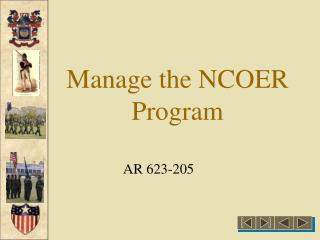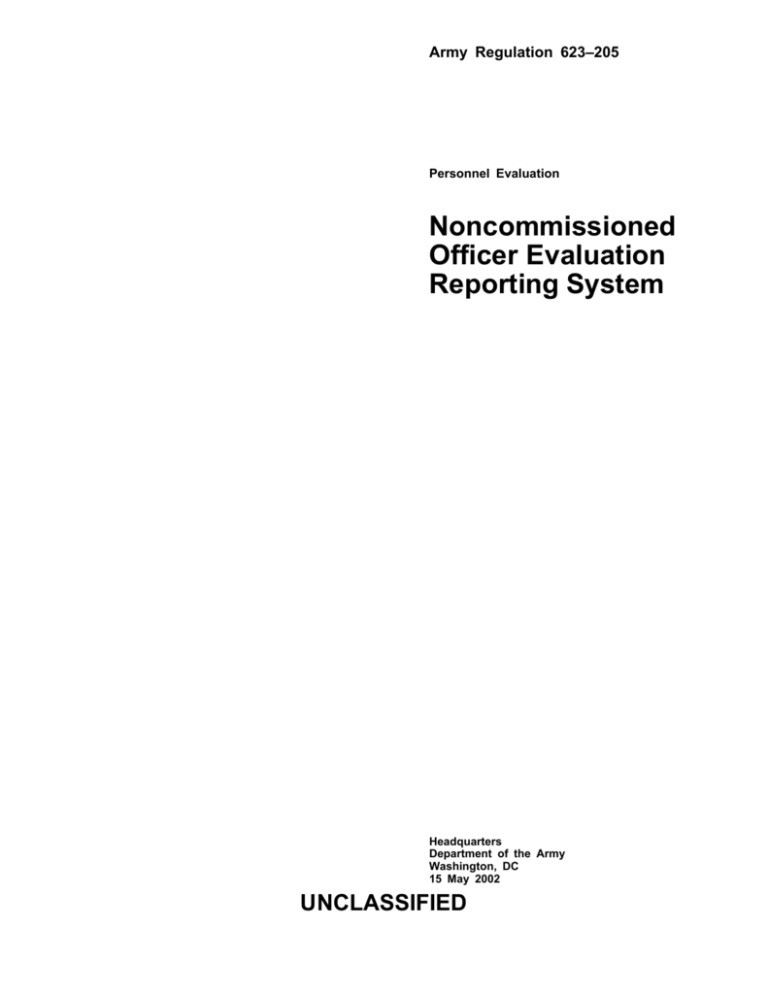Ncoer Regulation Ar 623 205
Being a noncommissioned officer (NCO) in the Army is a position of great responsibility and honor. As an NCO, one of your key duties is to provide feedback and evaluation to your subordinates through the Noncommissioned Officer Evaluation Report (NCOER) process. This report plays a critical role in the professional development of soldiers and is governed by Army Regulation (AR) 623-3. In this post, we will explore the key aspects of AR 623-3 and provide valuable insights and guidance for NCOs.
Understanding the NCOER Process
The NCOER is a comprehensive assessment tool that evaluates the performance and potential of NCOs. It provides an opportunity to recognize and reward high-performing soldiers while identifying areas for improvement. The process involves gathering information, conducting counseling sessions, and documenting the evaluation in the appropriate form.
Image source: Armywriter.com
When preparing an NCOER, it is crucial to be familiar with the guidelines outlined in AR 623-3. This regulation serves as the foundation for conducting fair and accurate evaluations of NCOs. It provides detailed instructions on the various aspects of the NCOER, including the rating schema, counseling requirements, and performance objectives. By adhering to these guidelines, NCOs can ensure their evaluations are consistent and in compliance with Army standards.
Key Components of the NCOER
The NCOER consists of several important sections that collectively contribute to an effective evaluation. Understanding these components will help NCOs provide thorough and precise assessments:
1. Army Values
The first section of the NCOER focuses on how well the NCO demonstrates the Army Values in their daily actions. Evaluators assess the NCO's commitment to the values of loyalty, duty, respect, selfless service, honor, integrity, and personal courage. This section aims to determine the NCO's adherence to ethical standards and their ability to serve as a role model for subordinates.
2. Competence
The competence section evaluates the NCO's technical and tactical proficiency in their assigned duties. It assesses the NCO's ability to perform tasks specific to their profession, such as leadership, training, and mission accomplishment. This section also considers the NCO's ability to adapt to changing situations and solve problems effectively.
3. Physical Fitness and Military Bearing
Physical fitness and military bearing are crucial aspects of an NCO's evaluation. This section examines the NCO's ability to maintain physical readiness through consistent fitness training. Additionally, it assesses their overall military appearance, demeanor, and adherence to military customs and courtesies.

Image source: SlideServe.com
Common Misconceptions and FAQs
Many NCOs have questions and concerns when it comes to the NCOER process. Let's address a few common misconceptions and frequently asked questions:
1. Can I personally choose who evaluates me?
No, as an NCO, you cannot choose who evaluates you. Evaluations are typically conducted by individuals who have firsthand knowledge of your performance and abilities. However, the final rating is usually reviewed by higher-ranking personnel to ensure objectivity.
2. How often should I conduct counseling sessions with my subordinates?
According to AR 623-3, counseling sessions should occur quarterly. These sessions provide an opportunity to discuss performance, set goals, and address any concerns or issues. Regular and effective counseling helps build a strong foundation for accurate evaluations.
3. What should I do if I disagree with my evaluation?
If you disagree with your evaluation, you have the right to appeal the decision. The appeals process allows NCOs to present additional information or arguments to support their case. It is essential to gather evidence and clearly articulate your reasons for the appeal.
The Importance of Accurate and Objective Evaluations
Accurate and objective evaluations are essential for the growth and development of NCOs and the overall success of the Army. The NCOER process provides a mechanism to identify strengths, areas for improvement, and potential future leaders.
By focusing on fairness, honesty, and maintaining the highest standards, NCOs can ensure their evaluations contribute positively to the professional growth of their subordinates and the organization as a whole.
Disclaimer: The information provided in this post is based on Army Regulation (AR) 623-3 and is intended to serve as a general guide. It is essential to consult the official regulation and seek guidance from your chain of command to ensure compliance with current policies and procedures.
Conclusion
Understanding and applying the principles outlined in Army Regulation (AR) 623-3 is essential for NCOs to conduct accurate and fair evaluations of their subordinates. By adhering to the NCOER process and its guidelines, NCOs contribute to the professional growth of soldiers and the overall success of the Army.
Remember always to stay updated with the latest version of the regulation and seek guidance from your chain of command for any specific questions or concerns related to the NCOER process.
Frequently Asked Questions
1. What is the purpose of the NCOER?
The purpose of the NCOER is to assess and document the performance, potential, and qualifications of NCOs in the U.S. Army.
2. How often should NCOERs be conducted?
NCOERs should be conducted annually for all NCOs, as well as during certain specified events, such as promotion boards or reassignment.
3. Can an NCO appeal their evaluation?
Yes, an NCO has the right to appeal their evaluation if they believe it is inaccurate or unjust. The appeals process allows them to present additional information or arguments to support their case.
4. Is counseling mandatory before conducting an NCOER?
Yes, counseling is mandatory before conducting an NCOER. Regular counseling sessions provide an opportunity for open communication and goal setting.
5. Can an NCO change their rating on the NCOER?
An NCO cannot change their rating on the NCOER. However, they can appeal the evaluation if they believe it is unjust or inaccurate.
References
- Army Regulation 623-3: Evaluation Reporting System
- SlideServe.com
- Armywriter.com
Create Post Length: 1583 words
Oer Form - Fill Out And Sign Printable PDF Template | SignNow
 Image Source : www.signnow.com
Image Source : www.signnow.com oer fillable signnow pdffiller proponent dcs
Army Ncoer Regulation 623 3 - Army Military
Ncoer PowerPoint (PPT) Presentations, Ncoer PPTs - SlideServe
 Image Source : www.slideserve.com
Image Source : www.slideserve.com Army Ncoer Regulation - Army Military
Army OER Regulation AR 623-3
 Image Source : www.part-time-commander.com
Image Source : www.part-time-commander.com Ar 623-205 Ncoer - USU Military Science
 Image Source : studylib.net
Image Source : studylib.net NCOERSupportFormDraft.pdf - HQDA#: 716152 NCO EVALUATION REPORT SUPPORT
 Image Source : www.coursehero.com
Image Source : www.coursehero.com nco
Has Anybody Successfully Submitted An Appeal Against A Falsified NCOER
 Image Source : www.rallypoint.com
Image Source : www.rallypoint.com Oer fillable signnow pdffiller proponent dcs. Army ncoer regulation. Oer form. Army oer regulation ar 623-3. Ncoer powerpoint (ppt) presentations, ncoer ppts